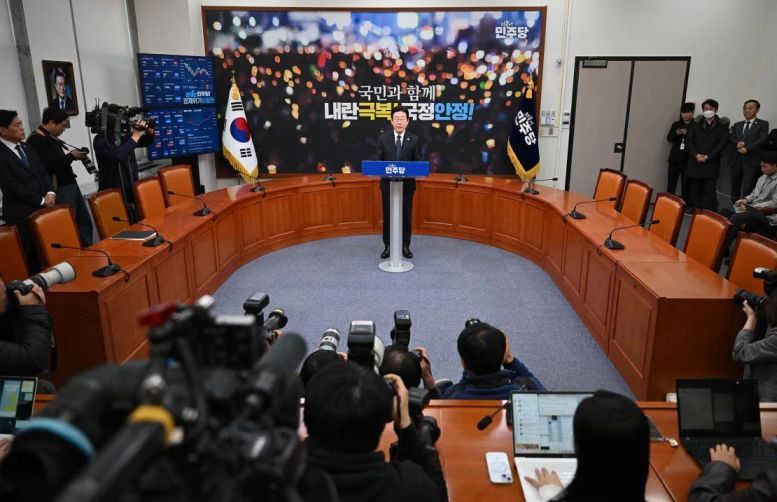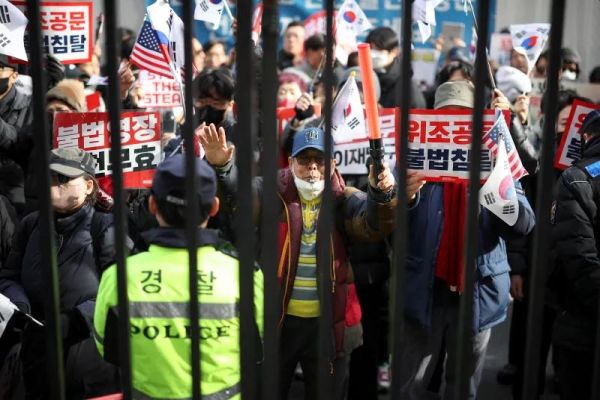By Eric Vandenbroeck and co-workers
Can South Korea’s Democracy Survive?
Having covered South Korea before, on December 3, South Korean President
Yoon Suk-yeol tried to demolish
his country’s democracy. In a shocking late-night television address, Yoon
declared “emergency martial law” and put the country under military rule. He
prohibited all political activities and suspended freedom of speech and the
press. He instructed his army chief to shut down the National Assembly
controlled by the opposition Democratic Party and sent the police and special
forces to prevent lawmakers from entering the building. By way of
justification—and borrowing a page from the political theorist Carl Schmitt’s
concept of a “state of exception”—Yoon declared that he was subverting liberal
democracy to save it.
South Koreans did not
take kindly to Yoon’s power grab. Throngs of people rushed to the outside of
the assembly building to protest. Lawmakers raced there as well, scaling fences
to enter as protesters blocked soldiers who tried to give pursuit. In a late-night
session, the assembly voted to revoke the president’s order, as it is legally
empowered to do (which is why Yoon attempted to shut it down in the first
place). After two more weeks of national outrage and mass protests, and with
polls showing that 75 percent of Koreans wanted him gone, the assembly voted to
impeach Yoon, 204 to 85. He was then suspended from his duties. Whether he
returns or is permanently removed from office depends on the country’s
Constitutional Court, which has up to six months to rule on the matter.

The events of the
last two months demonstrate the resilience of South Korea’s democracy, which
was established in the late 1980s after decades of military dictatorship. But
they also underscore why the country’s people are perennially anxious about
their freedom. Democracy is a process, not a state, and the night of December 3
illustrates that South Korea’s is both more and less vulnerable than was
commonly thought.
South Koreans have a
long road ahead as they try to dig out from Yoon’s failed autocoup. The
president’s conservative People’s Power Party (PPP) remains generally
supportive of him and is catering to extremist elements within the country. The
liberal Democratic Party is struggling to seize the political moment, and its
standard-bearer is facing controversies of his own. Fixing the country will
thus ultimately fall on the shoulders of ordinary South Koreans rather than
political leaders. To do so, they must overcome the gender divide, generational
barriers, and deluge of misinformation that has rocked the country’s politics.
Down With the Ship
South Korean law
allows presidents to declare martial law in times of war or during an equivalent
public emergency. But when Yoon got on television, there was nothing of the
sort: he simply made vague, baseless references to “threats of North Korean
communist forces” and pledged “to immediately eradicate the unscrupulous
pro-Pyongyang antistate forces that pillage the
freedom and happiness of our people and to protect free constitutional order.”
Most South Koreans
saw through these excuses. But the president’s rhetoric had a niche audience. A
surging far right in South Korea believes that North Korea is interfering in
its elections. (Yoon acted on this particular conspiracy theory by sending soldiers
to raid the National Election Commission shortly after he declared martial
law.) These South Koreans, mostly aggrieved elderly traditionalists and angry
young men, get their news from right-wing YouTube videos. They ignore
mainstream journalists and establishment opinion leaders, including
conservative ones, who largely condemned Yoon’s attempted self-coup.
The South Korean far
right is not just Yoon’s political base. It is also emerging as the base of his
party. As a result, the PPP has not functioned as a restraint on extremism as
conservative parties do in healthy democracies, instead remaining loyal to the
disgraced president and his diehard followers. The party’s leader, who publicly
supported impeachment, was replaced on December 16 by a pro-Yoon lawmaker. The
few conservative legislators who voted to impeach the president have also found
themselves sidelined. Yoon’s rabid supporters have shown up in front of the
presidential residence waving South Korean and U.S. flags and holding “Stop the
Steal” posters. They are vastly outnumbered by the hundreds of thousands of men
and women, young and old, who wave light sticks and sing “Impeach Yoon Suk-yeol.” But the PPP is pandering to a vocal minority rather
than discarding Yoon and tacking toward the center.

The party’s
reluctance has produced a protracted crisis. The South Korean prime minister,
also from the PPP, became acting president after Yoon’s impeachment. But rather
than trying to unite the country by shunting Yoon aside, he refused to sign off
on the assembly’s appointees to fill three empty seats on the
Constitutional Court, jeopardizing the court’s ability to review Yoon’s
impeachment. He too, was then impeached. Next in line to head the caretaker
government was the finance minister, who allowed two of the three court
appointments. But he vetoed a bill establishing a special counsel to
investigate Yoon for the high crime of “insurrection,” a capital offense.
Yoon is being
investigated for insurrection anyway by the federal office that investigates
corruption accusations against high-ranking officials. But he is doing his
utmost to obstruct the inquiry by refusing to cooperate with it and has called
on supporters to “fight to the end.” When investigators and police entered the
presidential compound on January 3 to detain him for questioning after he
refused to respond to previous summons, Yoon had the presidential security
service blockade them. Authorities returned with massive force on January 15,
and Yoon was arrested. He begrudgingly appeared before the Constitutional Court
to defend himself against impeachment but still refuses to answer questions
from the corruption investigation office. On Sunday, Yoon became the first
sitting president in Korean history to be indicted, on the charge of
insurrection.
This gridlock could
hardly come at a worse time. South Korea is one of the most dynamic economies
in the world and one of the United States’s most important allies. But it faces
a slew of geopolitical and economic challenges. The value of the Korean won has
plummeted to levels not seen since the 2008 global financial crisis, and the
country’s stock market ended the year as one of the worst performers in Asia.
Now that U.S. President Donald Trump has returned to the White House, South
Korea’s record trade surplus with the United States could make it a target for
tariffs. And South Korea could suffer collateral damage if Trump restarts his
trade war with China. Trump is also likely to demand that Seoul foot more of
the bill for housing American troops on the peninsula, stress-testing the
U.S.-South Korean alliance at a time when North Korea is strengthening its
military ties with Russia. As North Korean soldiers gain battlefield experience
by joining Russia’s fight against Ukraine, South Korea is essentially without a
commander in chief.

Bottom-Up Democracy
South Korea’s
immediate crisis will likely end in the months ahead. The Constitutional Court
is expected to uphold Yoon’s impeachment: if it does, Koreans will then trudge
back to the polls, as an election would have to be held 60 days of such a
ruling. And that election will be the Democrats’ to lose. Should the liberal
party win, its president will enjoy a sizable (close to two-thirds) majority in
the legislature and be governing a public hungry for real change. The party, in
other words, would have a mandate to tackle the roots of problems that made
Yoon so unpopular and desperate to begin with: the rising cost of living, a
prolonged doctors’ strike, influence peddling, and corruption. The PPP,
meanwhile, would have to rebuild after an electoral trouncing, which could give
moderates a chance to drag the party toward the center.
But as Korean
conservatives prepare for a long night of wrestling with their demons, liberals
are facing troubles of their own. Their most powerful politician, the party
leader and legislator Lee Jae-myung, faces a swarm of indictments, mostly
stemming from a controversial development project during his years as a city
mayor. He was convicted in November of making a false statement during the last
presidential campaign in violation of election laws. Despite Lee’s legal
troubles and often divisive reputation, many liberals still see him as exactly
what the country needs: a fighter for the working class who rose from poverty
to become a labor lawyer and progressive politician, someone who combines the
brashness of Trump with the policies of the progressive U.S. senator Bernie
Sanders. Lee, for his part, claims the various charges against him are
politically motivated, and he is appealing his conviction. But if the Supreme
Court upholds the guilty verdict before a snap election is held, Lee will be
disqualified from running, and the Democrats will suddenly be without an
obvious front-runner.
Thankfully, the fate
of Korean democracy does not rest in any one person’s hands, not even the next
president’s. That is the ultimate lesson of December 3, when, in a moment of
crisis, ordinary South Koreans came together. Yes, the lawmakers who raced to
their chambers were essential. But so was the crowd that helped them inside and
stood up to military troops. So were the journalists who continued reporting
despite the gag order. Even the police officers and soldiers who carried out
Yoon’s outrageous orders did so with a notable lack of enthusiasm. They did not
dare use force against the people.
Restoring the health
of South Korean democracy will require giving this civil society more
authority. As the political scientist Erik Mobrand
argued in his prescient book Top-Down Democracy in South Korea, the
country’s young democracy is overdue for a bottom-up reform of institutions to
increase citizen participation. Elites, Mobrand
notes, have manipulated the moment after political crises to limit the
influence of grassroots forces. Instead, it is time for the grassroots to
demand a more open and inclusive electoral process and party system, with more
public participation and less legal regulation. Ordinary South Korean citizens
are ready to play such an enhanced role, as they have proved not only through
mass protests but also consistently high election turnouts.
To foster more civic engagement,
journalists will need to do a better job at reaching groups that are tuning out
the mainstream press and falling into rabbit holes of misleading online
commentary. Educators also have a big role to play by enhancing civics
instruction and teaching young people the politics of problem solving rather
than partisanship. Civil society organizations need to help South Koreans
better distinguish what’s real from what’s fake, combating the distortionary
effects of the YouTube information ecosystem that emboldens Yoon and his
supporters. The country also needs to put more work into bridging its
sociopolitical divides, particularly between young and old and between men and
women. To that end, the next administration, liberal or conservative, should
support intergenerational initiatives that can reinvigorate civic life and
promote gender equality. And ultimately, South Koreans may decide the time has
come to revise the constitution, written in 1948 under U.S. military occupation
and last revised in 1987 under military dictatorship.
None of these steps
will be easy. The country’s democracy will face serious struggles, even if
Yoon’s night of martial law is just a bad memory. But South Korea’s citizens
are up to the task. If they stopped a military dictatorship overnight, just as
they deposed an earlier generation of autocrats, they can right their ship in
the years ahead.
For updates click hompage here